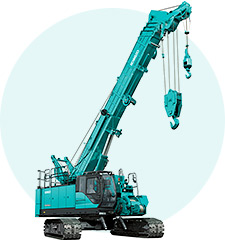
On June 2017, sales commenced for TK750G/TK750GFS (hereafter TK750G), a new model of the extremely well-received TK Series, which performs outstandingly in spite of the tough conditions of a general construction site. With all the conventional features such as a robust structure, outstanding operability and high lifting capability, this landmark model satisfies the new industry expectations for "under 3m transportation width".
Slimming down the model while maintaining its performance
The conventional TK Series was highly evaluated. However, conformity with 2014 emission gas regulations became an urgent issue. Takayoshi Aoishi, who was in charge of the marketing strategy, recalled the following.
However, every time a crawler crane is transported by trailer, A “special vehicle permit” is required of the unit. The preparation of documents, the complicated application procedure, the lead time required before the permit is approved, the waiting time until the transport trailer is deployed and the limits of transportation time; all these factors acted to suppress the actual operation time of the crane.
But for Masaaki Higuchi, who was in charge of sales and actually dealt with customers directly, worried about it at the time.
To overcome this difficulties, the development team attended meetings with customers in various locations to hear their thoughts on the matter. These meetings served to deepen their conviction that "changing the vehicle width was absolutely necessary". Project manager Takahiro Hanamoto remembered the following.
So, Aoishi drew up 8 simulation scenarios that assumed various conditions.
In April 2014, backed by Hanamoto’s slogan, "Imagine 10 years later and see what nobody's seen before", the project officially began.
 We achieved a compact layout with a minimum transportation width of 2.99m.
We achieved a compact layout with a minimum transportation width of 2.99m.
As a new option, we equipped the model with a boom detachment apparatus
and a crawler self-detachment apparatus which substantially improved transportability.
An immediate asset in severe workplaces
The theme of the project was to maintain the strength of the slimmed down unit while effectively attaching various elements including an engine. Yoshio Sasaoka, who was in charge of the overall design, addressed this task.
For the engine, we adopted Daimler AG's "OM936LA (MTU6R1000)". The engine carries a "Urea Selective Catalytic Reduction" as exhaust gas postprocessing device for reducing PM (particulate matter) and NOx (nitrogen compound) emissions. What's more, the engine cleared the standard value for construction machine noise reduction.
On the other hand, Akira Okada, who was in charge of the system development, had a problem in maintaining a fixed temperature around the engine.

Brushing up from the customer’s viewpoint
With the TK750G, we maintained the performance of the conventional machines which was extremely well-received by our customers.
Also, Takeya Miyamura, who was in charge of the trials, emphasizes that the viewpoint of customers were foremost in his mind even during the testing stage.
The model was finished with the default value at an average that anybody would find reasonable and the detailed settings were left to be fine-tuned at the time of the vehicle’s delivery. The knowhow accumulated in this development project is sure to contribute in the development of future TK Series models.
The TK750G is already enjoying a succession of inquiries from many customers. The members of the development team commented, “We would like to have the model applied in the severe construction site right along with our conventional machines and the machines of other companies.”
* The contents described above is based on the information at the time of issuing (October, 2017).










Aoishi
In terms of time and cost effectiveness, we felt that the model development of the new TK750 with the well-rooted evaluation would be best served by simply replacing the engine with one that conformed with the 2014 emission gas regulations at the beginning.